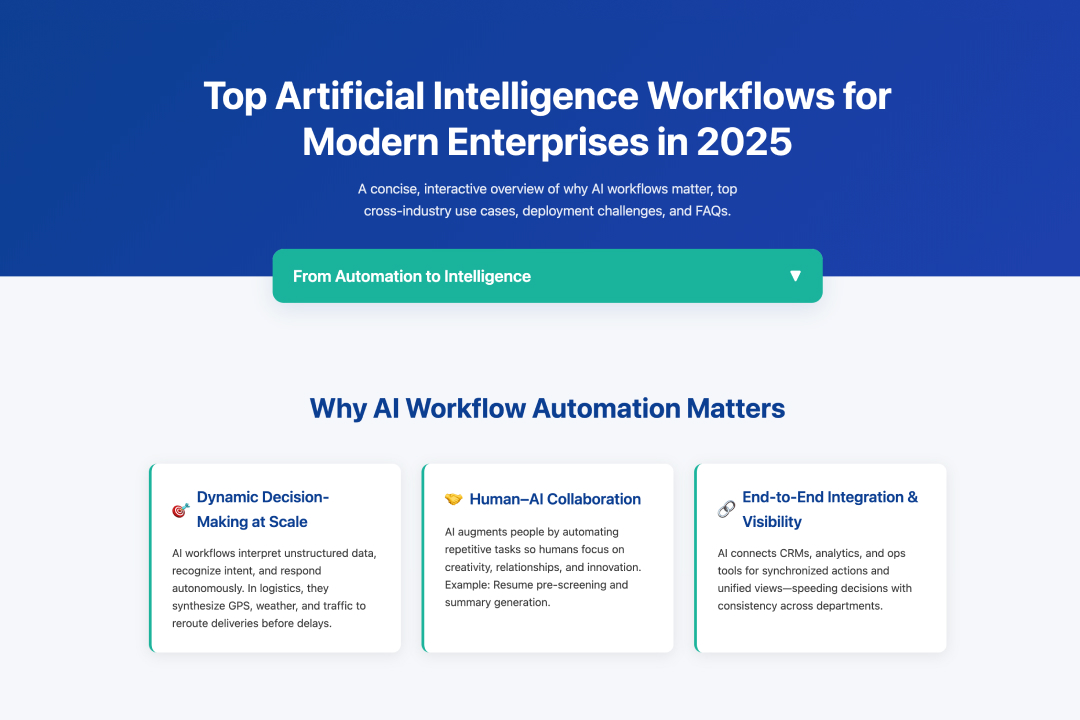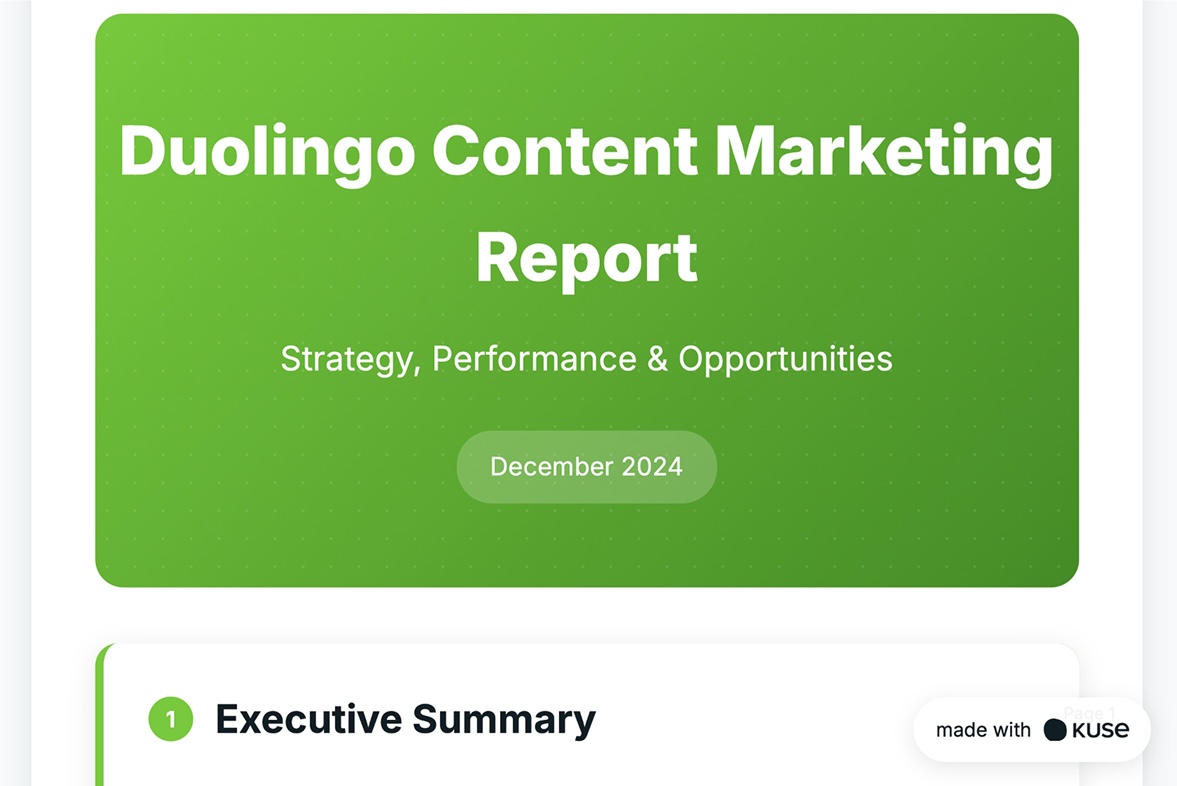Top Artificial Intelligence Workflows for Modern Enterprises in 2025
Discover how artificial intelligence workflows are transforming business operations in 2025. Learn why intelligent workflow automation matters, explore leading use cases across industries, and understand how enterprises can overcome adoption challenges.

Introduction: From Automation to Intelligence
Traditional automation focused on efficiency — repeating the same steps faster.
In 2025, artificial intelligence workflows elevate that concept by introducing adaptability, learning, and context.
Instead of just automating tasks, they interpret data, predict outcomes, and make real-time decisions — effectively merging automation with cognition.
These workflows power modern enterprises by connecting data systems, analyzing insights, and executing actions autonomously.
As outlined in our earlier post - How to Build Intelligent Workflow Automation That Drives Business Results in 2025 - intelligent workflows are the core of digital transformation. This article explores the most transformative AI workflows being implemented across sectors, why they matter, and what challenges organizations must address to scale them effectively.
Why AI Workflow Automation Matters in 2025
AI workflow automation isn’t simply a technological trend — it’s a strategic capability for modern enterprises.
Three key drivers make it indispensable for business resilience, speed, and competitiveness.
1. Dynamic Decision-Making at Scale
Most organizations today face an overwhelming data flood — from customer feedback to supply chain metrics — yet decision-making often remains manual and reactive.
AI workflows introduce decision intelligence, enabling systems to interpret unstructured data (emails, chat logs, or IoT signals), recognize intent, and respond autonomously.
For instance, in logistics, an AI workflow can synthesize GPS data, weather patterns, and traffic updates to automatically reroute deliveries before delays occur — minimizing downstream disruption without any human escalation.
This shift from rule-based triggers to adaptive, context-aware decision-making marks a fundamental change: workflows no longer follow instructions — they understand context and act intelligently.
2. Human–AI Collaboration as a Competitive Edge
AI workflows don’t eliminate people; they enhance them.
By automating repetitive analytical or clerical work, teams can refocus on high-value tasks such as creative problem-solving, relationship-building, and innovation.
Imagine an HR manager reviewing hundreds of resumes. Instead of scanning every document, an AI workflow pre-screens candidates, categorizes strengths, and generates summaries — allowing the manager to invest time in interviews and human connection.
In short, intelligent workflow automation augments human capability — creating a hybrid model where machines handle scale, and humans handle nuance.
3. End-to-End Data Integration and Visibility
Siloed systems are a major productivity barrier.
AI workflows connect disparate software — from CRMs to analytics platforms — allowing real-time synchronization across teams and departments.
When properly orchestrated, this integration produces a unified operational view: a marketing action triggers CRM updates, analytics dashboards adjust dynamically, and leadership gains immediate insights into overall performance.
The value here isn’t just speed — it’s visibility and consistency, ensuring every department works from the same intelligence layer.
Enterprises that achieve this integration move faster, communicate clearer, and make better-informed strategic choices.
Top Use Cases of Artificial Intelligence Workflows Across Industries
AI workflows are highly versatile — adapting to the specific needs, compliance standards, and data structures of each sector. Below are several of the most impactful use cases shaping industries in 2025.
1. Customer Service and Experience
AI workflows use natural language processing (NLP) to understand customer messages, analyze tone, and predict urgency.
When a support email arrives, the system automatically categorizes it by topic, retrieves relevant order data, drafts a contextual response, and routes unresolved cases to the right department.
This approach not only reduces repetitive manual triage but also ensures that every interaction feels personalized. In industries with high customer volume — such as telecommunications or retail — this leads to faster resolutions and more consistent brand experiences.
2. Finance and Banking
Financial institutions deploy AI workflows to automate processes that demand precision and compliance, such as loan underwriting, credit analysis, and fraud detection.
These workflows leverage machine learning models that continuously learn from transaction history, identifying subtle patterns indicative of potential risk or opportunity.
For example, when irregular payment behavior occurs, an AI workflow can automatically trigger an alert, initiate temporary account restrictions, and assign a compliance review — maintaining regulatory standards while reducing manual workload.
3. Human Resources and Recruitment
HR departments use AI-enhanced workflows to streamline both hiring and onboarding.
An AI system can parse job descriptions, extract relevant qualifications, and automatically shortlist candidates based on data rather than intuition.
Once hired, onboarding workflows integrate HRIS systems, payroll, and document management tools — generating customized checklists and automating communication reminders.
The result is a smoother employee journey and a consistent organizational experience from day one.
4. Healthcare
Healthcare providers increasingly rely on AI-driven administrative workflows to manage the vast volume of unstructured data from patient records, test results, and doctor notes.
NLP algorithms can extract diagnosis codes from free-text medical records, while machine learning models help prioritize cases that require urgent review.
This allows medical professionals to focus on patient care while ensuring documentation accuracy and faster insurance processing — a critical factor in reducing burnout and improving patient satisfaction.
5. Manufacturing
Manufacturers are using intelligent workflows for predictive maintenance and supply chain orchestration.
AI systems ingest IoT sensor data from machinery, detect early signs of equipment degradation, and automatically create maintenance requests before breakdowns occur.
When anomalies are detected, the workflow can also coordinate with suppliers to secure replacement parts, update production schedules, and adjust delivery expectations.
This holistic automation keeps production lines running smoothly and prevents costly operational interruptions.
6. Marketing and Sales
Modern marketing teams employ AI workflows for data-driven campaign management.
Instead of manually analyzing engagement data, AI models continuously evaluate audience interactions, content effectiveness, and market signals.
When the system detects performance fluctuations — such as declining click-through rates or shifting customer sentiment — it automatically adjusts messaging, rebalances ad budgets, or triggers follow-up sequences in connected CRM tools.
This creates a real-time feedback loop that sustains marketing efficiency and message relevance.
7. Education and Research
Universities and research institutions use AI workflows to automate administrative and academic tasks.
For example, during admissions, AI systems analyze applications, categorize candidates, and flag those that best align with program criteria.
In research environments, AI workflows help track grant proposals, manage compliance reporting, and aggregate publication metrics — improving both transparency and data consistency across departments.
Common Challenges When Deploying AI Workflows
While AI workflows promise remarkable efficiency, their implementation introduces new technical, organizational, and ethical complexities.
Successful deployment requires acknowledging — and actively addressing — these core challenges.
1. Integration Complexity
Enterprises often rely on a patchwork of legacy systems built over decades. Many of these lack standardized APIs, making integration with AI orchestration tools difficult.
To resolve this, organizations can use middleware or intelligent connectors that act as translators between systems. However, integration still requires careful data mapping, authentication setup, and version control to ensure accuracy and security.
2. Data Quality and Governance
AI workflows are only as reliable as the data they process.
Inconsistent formatting, duplicate entries, or missing values can cause misclassification or flawed predictions.
Implementing strong data governance frameworks — with standardized inputs, quality checks, and validation protocols — is crucial. This not only improves AI model performance but also strengthens regulatory compliance.
3. Model Drift and Maintenance
AI models degrade over time as real-world conditions change. A predictive model trained on last year’s data might fail under new market dynamics or policy shifts.
Continuous retraining and monitoring are necessary to prevent model drift. Organizations should schedule periodic evaluations, apply versioning, and track accuracy metrics to ensure sustained reliability.
4. Ethical and Explainability Concerns
As AI begins to influence critical decisions — in hiring, lending, or healthcare — transparency becomes paramount.
Stakeholders must be able to understand why a model made a specific decision. Explainable AI (XAI) dashboards, audit trails, and human-in-the-loop validation help preserve accountability while maintaining user trust.
5. Organizational Change Management
Introducing AI workflows often challenges established ways of working.
Employees may feel uncertainty about automation or fear redundancy.
The key is education and inclusion — involving teams early in design phases, communicating clearly about AI’s role, and demonstrating its benefits through pilot projects.
When employees see AI as a partner rather than a threat, adoption accelerates naturally.
6. Cost and Scalability Barriers
Building and maintaining intelligent workflows can require significant investment in data infrastructure, compute resources, and specialized expertise.
Enterprises should start small — automating high-value, low-risk processes first — then scale gradually based on demonstrated ROI.
Cloud-native platforms and modular architecture can also help balance scalability with affordability.
Conclusion
Artificial intelligence workflows are redefining operational intelligence for modern enterprises.
By merging automation with contextual awareness, they enable organizations to make faster, smarter, and more consistent decisions.
However, success requires thoughtful integration, transparent governance, and a people-first approach.
The future of enterprise automation isn’t just about machines doing the work — it’s about humans and AI building systems that learn, evolve, and collaborate.
Related Reads:
How to Build Intelligent Workflow Automation That Drives Business Results in 2025
Business Intelligence Workflow: Turning Data Into Decisions
FAQs
1. What is an artificial intelligence workflow?
An artificial intelligence workflow is a business process that integrates AI technologies — such as machine learning, NLP, and predictive analytics — to automate, optimize, and adapt operational tasks in real time.
2. How do AI workflows differ from traditional automation?
Traditional automation executes predefined actions; AI workflows interpret context and make data-driven decisions dynamically. They can learn from outcomes and continuously refine performance.
3. What industries use AI workflows most effectively?
Sectors with high data volume and complexity — such as finance, healthcare, logistics, and manufacturing — benefit the most. AI workflows streamline compliance, detect anomalies, and enhance visibility across distributed systems.
4. What skills are needed to implement AI workflows?
A successful implementation requires collaboration among data engineers, ML specialists, domain experts, and change management professionals. Combining technical and business expertise ensures both scalability and usability.




